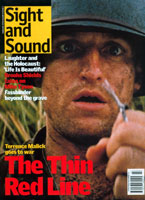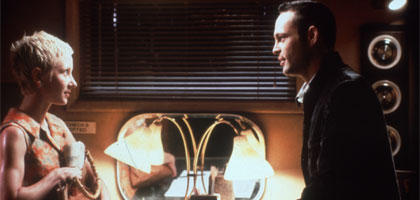
Playing with horrific farce
Film of the Month: Psycho

Gus Van Sant's rerun of Hitckcock's, Psycho is more like a mild cover version than a full-blown remake. But it's all in the mix, argues Gavin Smith
Gus Van Sant's remake of Alfred Hitchcock's canonical 1960 film Psycho - in which thief-on-the-lam Marion Crane (Janet Leigh in the original, Anne Heche here) is murdered by hotel-owner Norman Bates (Anthony Perkins then, Vince Vaughn now) - isn't the self-defeating, perverse exercise it might seem at first glance. It's more a work of 'metacinematic' research. By remaking Psycho, the film-makers have managed to replay formally notions of transgression and difference that manifested themselves in Hitchcock's original as themes and subtexts. So Van Sant's Psycho is both more and less than a remake. More in the sense that it literalises the notion of remaking by copying or transcribing Hitchcock's 1960 film, less in that it denies the standard remake strategy which demands that the remake transcend its origins by revision (Cape Fear, Scarface).
On the contrary, Van Sant's Psycho, with its ritualistic attention to detail, could be described as a re-enactment or, as he has suggested, as the equivalent of a cover version of a classic song. But critically, given that contemporary cinema has been permeated by the strategies and tactics of the original film, Van Sant can neither reproduce the effect Hitchcock's film had on its contemporary audience - its impact - nor escape the burden of its place in film history. If the theme of Hitchcock's Psycho is the terrible power of the past and how it blights the present, then it is doubly so for Van Sant - indeed this becomes the new Psycho's organising principle. The weight of the past on the present and the loss of autonomy afflicting Norman Bates become Van Sant's point of departure for this radical project.
Director and cinematographer (Chris Doyle of Chungking Express fame) have imposed on themselves a set of extremely tight expressive constraints to minimise deviation from the original movie. Their film uses the same score, is more or less the same running time and, most crucially, employs the same screenplay. If anything, Van Sant's strategy is subtractive rather than additive. Although several anachronisms are wilfully permitted to survive, Joseph Stefano's original script has been subtly abridged and pared so that, despite several enigmatically superfluous added lines, there is even less dialogue here than in the already sparse original.
On the other hand, given that the original derived much of its power from its no-frills black-and-white shooting style, Van Sant's film is in colour and therefore has a completely different effect. And although many scenes are reproduced exactly, this is by no means a shot-for-shot remake. Many shots only approximate those in the original, and in general the pacing seems faster - dialogue is more clipped, shot duration more varied. In many instances, though, there are significant embellishments: the shower scene (from Marion stepping into the bathtub to Norman descending from the house) is now a full minute longer and although many shots are identical, it includes a number of new images (a close-up of Marion's dilating pupil as she is stabbed; a blurred Marion's-eye-view of her killer departing; a fleeting, enigmatic image of billowing storm clouds). Van Sant and Doyle's shots, even those reproduced exactly from the original, seem comparatively casual and indefinite, lacking the starkness, deliberation and measurement of Hitchcock's. And the two films have completely different senses of space, particularly interior space. It is in such distinct yet unquantifiable differences that Van Sant's inquiry or research finds its form. The same is true of the film's determinedly muted, enervated tone and air of inconsequentiality.
Van Sant's Psycho is fundamentally an investigation of the expressive and thematic possibilities of nuance. Given the same script and more or less the same visual architecture, casting and direction of actors become key. Sure enough, Van Sant gets considerable mileage from the redeployment and reassignment of character values, enough to achieve a small but significant shift of meaning. Rather than using the modern equivalents, he selects actors who largely counter or contradict the original cast's qualities and associations. (Two exceptions: the perfect substitutions of William H. Macy for Martin Balsam as the private detective Arbogast, and Robert Forster in a bad hairpiece for Simon Oakland as the psychiatrist at the end of the film.)
Anne Heche, whose gay sexuality has become a matter of record, emphatically does not project the same sexuality that Janet Leigh brought to the role. Her Marion lacks Leigh's guilt, melancholy and mounting sense of entrapment. Where Leigh's Marion maintained a careful diplomatic distance from her boss' flirtatious client, Heche's Marion responds with ironic/sarcastic indulgence. Where Leigh is solemn, even grim, Heche is light, untroubled, almost breezy. Van Sant has reconceived her as someone lacking moral ballast and emotional complexity. Once alone in the motel room, she considers different hiding places for the money with the giddy excitement of a naughty child having fun. As a direct consequence of this comprehensive moral diminishment of Marion, Heche recedes as a screen presence in comparison with Leigh.
Conversely, Julianne Moore, as Marion's inquisitive sister Lila who comes looking for her, becomes a more commanding presence, giving the character more stature. More brusque in her dealings with her sister's lover Sam, and now delivering a coup de grace kick during the climactic struggle with Norman, she's more aggressively independent than Vera Miles' Lila. It's been suggested she's meant to be a lesbian, a reading perhaps substantiated by her dress style and several rebuffs of Sam's sexist arm around her shoulder. If so, this suggests a rethinking of Psycho as a kind of horrific farce of multiple sexual misapprehensions in which Norman's attraction to Marion is as unfortunate as Sam's to Lila.
Just as Marion's sexuality is suppressed in this version, Norman seems more outwardly normal: where Perkins is slim and frail, full of nervous movement, Vince Vaughn is a robust, grounded physical presence, more conventionally masculine, though with his babyface looks he exudes boyishness. In place of Perkins' stutter, he sports a vacant, nervous laugh. A Norman Bates with fewer outward indications of abnormality than originally, he becomes all the more subversive of and threatening to the prevailing heterosexual order, epitomised here by the smug hyper-masculinity of Viggo Mortensen's Sam, who sharply contrasts with the smooth but colourless assurance of John Gavin. Van Sant's Sam fondly pats the Gideon Bible in the motel room, but his right-wing credentials are certified by the gun and ammunition cases prominently displayed in his store.
These weapons are part of a chain of visual associations that extends from the toy soldiers, toy musket and poster of a Blackbird military reconnaissance plane in Norman's bedroom to the pictures of guns and military aircraft in the sheriff's office at the end. Although there is something psychologically unsatisfactory and pat in such an indictment of the fetishisation of violence and weaponry in gun-culture America, through these cult-of-violence symbols Van Sant subversively links the normative heterosexual authority represented by Sam and the sheriff with Norman's spoiled infantile sexual identity, striking a small blow against patriarchal values. Still, however low-yield the shift in meaning Van Sant accomplishes proves to be, it's enough to justify the experiment: same film, different meaning. Where Hitchcock's Norman is conclusively Other, Van Sant's is one of us.
